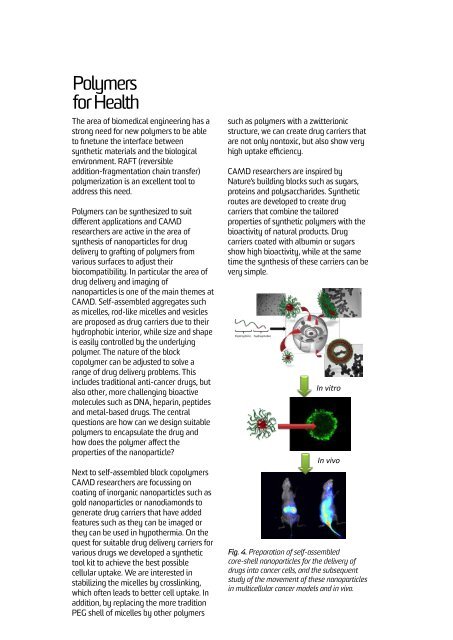CAMD_2015_Annual_Report
Create successful ePaper yourself
Turn your PDF publications into a flip-book with our unique Google optimized e-Paper software.
Polymers<br />
for Health<br />
The area of biomedical engineering has a<br />
strong need for new polymers to be able<br />
to finetune the interface between<br />
synthetic materials and the biological<br />
environment. RAFT (reversible<br />
addition-fragmentation chain transfer)<br />
polymerization is an excellent tool to<br />
address this need.<br />
Polymers can be synthesized to suit<br />
different applications and <strong>CAMD</strong><br />
researchers are active in the area of<br />
synthesis of nanoparticles for drug<br />
delivery to grafting of polymers from<br />
various surfaces to adjust their<br />
biocompatibility. In particular the area of<br />
drug delivery and imaging of<br />
nanoparticles is one of the main themes at<br />
<strong>CAMD</strong>. Self-assembled aggregates such<br />
as micelles, rod-like micelles and vesicles<br />
are proposed as drug carriers due to their<br />
hydrophobic interior, while size and shape<br />
is easily controlled by the underlying<br />
polymer. The nature of the block<br />
copolymer can be adjusted to solve a<br />
range of drug delivery problems. This<br />
includes traditional anti-cancer drugs, but<br />
also other, more challenging bioactive<br />
molecules such as DNA, heparin, peptides<br />
and metal-based drugs. The central<br />
questions are how can we design suitable<br />
polymers to encapsulate the drug and<br />
how does the polymer affect the<br />
properties of the nanoparticle?<br />
Next to self-assembled block copolymers<br />
<strong>CAMD</strong> researchers are focussing on<br />
coating of inorganic nanoparticles such as<br />
gold nanoparticles or nanodiamonds to<br />
generate drug carriers that have added<br />
features such as they can be imaged or<br />
they can be used in hypothermia. On the<br />
quest for suitable drug delivery carriers for<br />
various drugs we developed a synthetic<br />
tool kit to achieve the best possible<br />
cellular uptake. We are interested in<br />
stabilizing the micelles by crosslinking,<br />
which often leads to better cell uptake. In<br />
addition, by replacing the more tradition<br />
PEG shell of micelles by other polymers<br />
such as polymers with a zwitterionic<br />
structure, we can create drug carriers that<br />
are not only nontoxic, but also show very<br />
high uptake efficiency.<br />
<strong>CAMD</strong> researchers are inspired by<br />
Nature’s building blocks such as sugars,<br />
proteins and polysaccharides. Synthetic<br />
routes are developed to create drug<br />
carriers that combine the tailored<br />
properties of synthetic polymers with the<br />
bioactivity of natural products. Drug<br />
carriers coated with albumin or sugars<br />
show high bioactivity, while at the same<br />
time the synthesis of these carriers can be<br />
very simple.<br />
In vitro<br />
In vivo<br />
Fig. 4. Preparation of self-assembled<br />
core-shell nanoparticles for the delivery of<br />
drugs into cancer cells, and the subsequent<br />
study of the movement of these nanoparticles<br />
in multicellular cancer models and in vivo.


